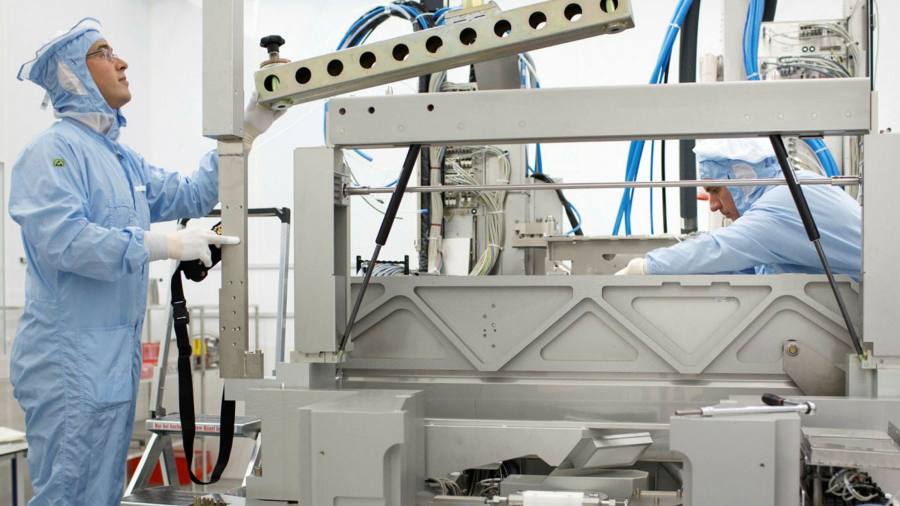How the global semiconductor tussle is shaping ASML’s future

The future looks unremittingly bright for ASML, Europe’s most valuable technology company, apart from one dot on the horizon: geopolitics. As the manufacturer of what one tech executive calls “the most complicated machine humans have built”, ASML is benefiting from the global boom for semiconductors that run our connected world.
On Wednesday, the Dutch company, which sells photolithographic machines to the world’s leading chip manufacturers, announced standout quarterly results. The company now boasts a stock market value of around $300bn, reflecting a nearly sixfold increase over the past five years. Growth prospects remain tantalising: ASML predicts that the semiconductor industry’s combined sales will double to $1tn by 2030. “Our customers are craving those machines,” says Peter Wennink, ASML’s chief executive.
However, like other semiconductor players, ASML is trapped in the tightening vice between the US and China as they vie for technological supremacy. How the company deals with this dilemma will tell us much about the future shape of our technological world. Under US pressure, the Dutch government is reviewing an export licence for ASML’s most advanced machines to China. Dividing the world into blue (US) and red (China) supply chains threatens to tear apart one of its most tightly integrated industries. For a company that has 5,000 suppliers, that may make life tricky and costly.
The focus of export controls is ASML’s extreme ultraviolet (EUV) technology, a miracle of modern engineering that uses light to etch integrated circuits on to silicon wafers at minuscule scale. Each EUV machine weighs 180 tonnes and costs more than $150m. ASML sells them to the likes of TSMC, Samsung and Intel. Chinese manufacturers appear desperate to buy them, too.
At present, more than three-quarters of ASML’s technology sales are to Asia, principally Taiwan, South Korea and China. But both the US and the EU are intent on strengthening their own domestic semiconductor-making capacity, dragging the industry’s centre of gravity westwards. Under the Wassenaar Arrangement between 42 countries, including the Netherlands, exports of technology with dual military and civil use are subject to government approval. Joe Biden may have replaced Donald Trump, but that has not changed US determination to cut the technological ground from under China’s feet and “friend-shore” semiconductor manufacturing.
In the short run, ASML may benefit from this market “inefficiency”, as the company quaintly calls the geopolitical reordering. US and European governments are enticing chipmakers to open plants locally. But wherever they build, these companies will remain enthusiastic customers for ASML’s machines. ASML is also benefiting from the rebound in the pandemic-suppressed global economy and the secular shift to on-device, or “edge”, computing.
Pierre Ferragu, managing partner of New Street Research, says the US strategy is straightforward and well-executed and has encouraged its traditional allies to fall into line. Several European countries have now rejected China’s Huawei in running 5G telecoms networks, for example. “China will not have leading edge semiconductor technology for two decades. It is a no-brainer for Europe to back the US side,” he says.
But a report from the US Silicon Industry Association and Boston Consulting Group warns that strategic decoupling from China could backfire, resulting in a slowdown of innovation, lost market share and a vast escalation of China’s manufacturing capability. The US may simply be stimulating the competition it wishes to starve.
For its part, ASML accepts that export controls are a valid tool for “targeted, specific, national security issues” but questions the harm they cause, if overused. They may further disrupt manufacturing capability at a time of global chip shortages.
The US policy of weaponising technology also risks stoking geopolitical tensions over Taiwan, where most advanced chip manufacturing is currently based and where China has “unknown red lines”, says Paul Triolo, head of Eurasia Group’s technology practice. “Governments should be very careful about messing with this global supply chain. For 40 years, we have all benefited from a very robust, open and free supply chain that has led to a huge amount of innovation.”
ASML has done a neat job in building a dominant position in a critical, fast-growing, capital-intensive industry. But its future success will partly depend on it acquiring a new skill: how to play 3D geopolitical chess.